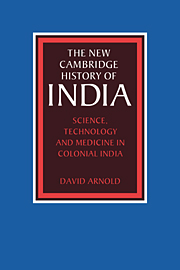Book contents
- Frontmatter
- 1 Introduction: science, colonialism and modernity
- 2 Science under the company
- 3 Western medicine in an Indian environment
- 4 Technologies of the steam age
- 5 Imperial science and the Indian scientific community
- 6 Science, state and nation
- Conclusion
- Biographical notes
- Bibliographical essay
- Index
- THE NEW CAMBRIDGE HISTORY OF INDIA
- References
3 - Western medicine in an Indian environment
Published online by Cambridge University Press: 28 March 2008
- Frontmatter
- 1 Introduction: science, colonialism and modernity
- 2 Science under the company
- 3 Western medicine in an Indian environment
- 4 Technologies of the steam age
- 5 Imperial science and the Indian scientific community
- 6 Science, state and nation
- Conclusion
- Biographical notes
- Bibliographical essay
- Index
- THE NEW CAMBRIDGE HISTORY OF INDIA
- References
Summary
Medicine occupied a central place in Western scientific thought and activity in nineteenth-century India. There were many reasons for this. Firstly, the Colonial Medical Service was one of the principal scientific agencies in India during the Company period and for several decades thereafter. Company surgeons and their successors under the Crown provided a large share of the botanists, geologists, zoologists, meteorologists, foresters and other specialists. Secondly, partly because of their wide-ranging scientific brief, medical personnel had a vital role in the European investigation of the Indian environment (including its topography, climate and diseases), and hence in understanding how nature fashioned the human condition in India. Thirdly, to a degree unparalleled in other scientific fields and matched by few aspects of technological change, medicine represented direct intervention in, and interaction with, the social, cultural and material lives of the Indian people. This dual engagement — with the environment and with culture — helped fashion not only the distinctive character and preoccupations of India’s colonial medicine, but also the manner of its Indian reception and assimilation. Although medical and sanitary intervention was initially driven by the scientific interests of the colonial state, over the course of the century medicine began to serve other agendas and to inform a wider cultural and political dialogue.
From the perspective of medical history, the demise of the East India Company in 1858 was not in itself particularly momentous, and it is more appropriate to see the nineteenth century as a whole. Some developments can usefully be traced through to the 1910s and 1920s, but this chapter is mainly concerned with the period up to the mid-1890s, when, in the wake of Robert Koch’s identification of the cholera bacillus and Ronald Ross’s discovery of the mode of malaria transmission and the outbreak of bubonic plague in India, there was a shift away from the environmental paradigm that had dominated nineteenth-century medical thought and the emergence of new scientific ideas, institutions and practices.
- Type
- Chapter
- Information
- Science, Technology and Medicine in Colonial India , pp. 57 - 91Publisher: Cambridge University PressPrint publication year: 2000
References
- 1
- Cited by

